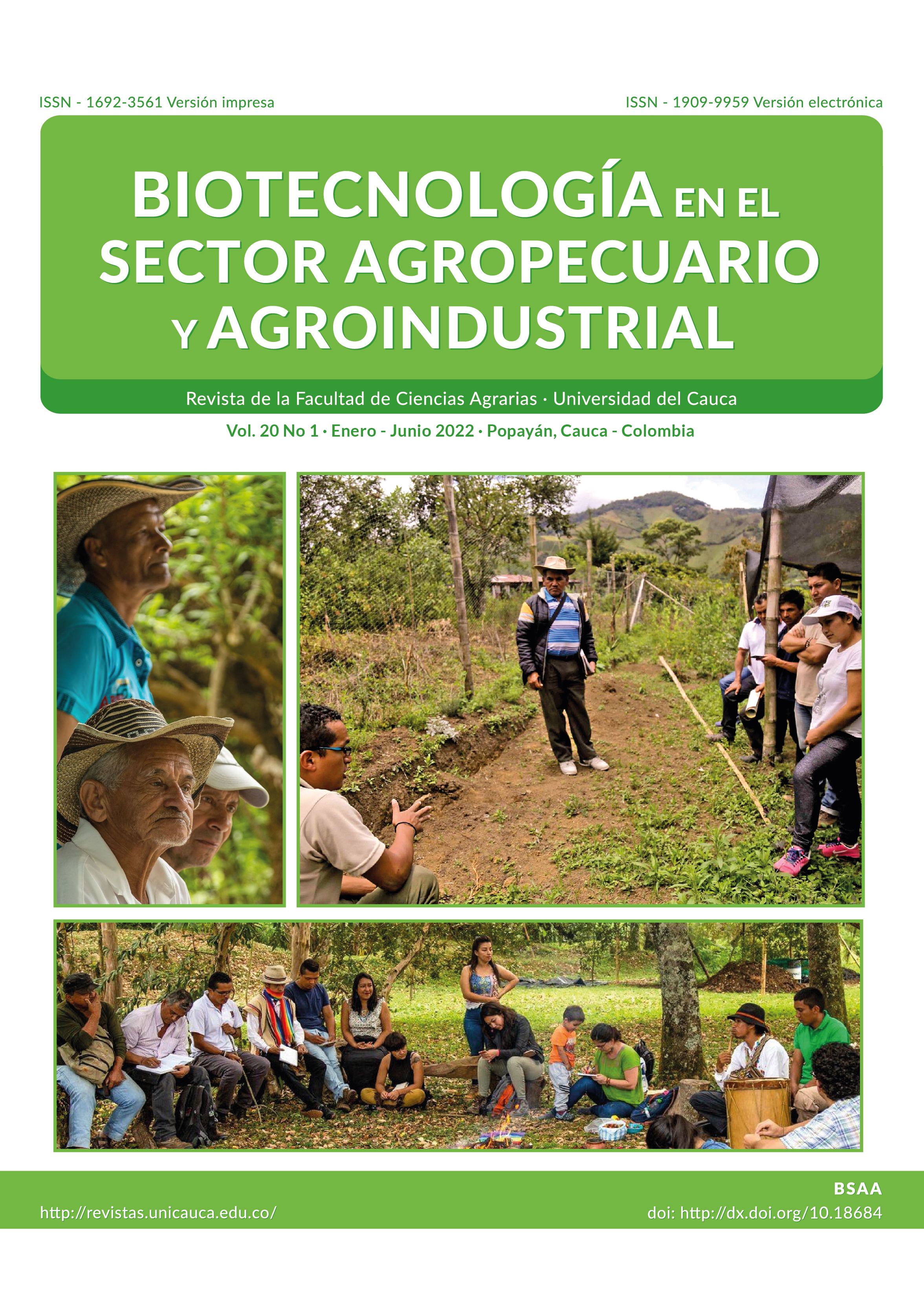Identificación molecular de hongos filamentosos y su potencial biotecnológico
Resumen
Los hongos filamentosos son organismos frecuentemente utilizados en el desarrollo de alternativas para resolver desafíos en diferentes sectores productivos. Igualmente, representan una oportunidad competitiva de valor económico en sectores como el agrícola, alimenticio y farmacéutico como también en el industrial y de biocombustibles. Dando continuidad a investigaciones previas de la Universidad Francisco de Paula Santander (UFPS), se analizaron 25 muestras del banco de cepas para caracterización molecular e identificación taxonómica. Se obtuvo ADN de cada cepa con la técnica fenol-cloroformo. Mediante las técnicas de PCR y de iniciadores de espaciadores internos de transcrito (ETS) primer 4 y 5, se obtuvieron los amplicones que fueron secuenciados. Se identificaron cepas de los ordenes Hypocreales, Eurotiales, Pleosporales y Saccharomycetales con ejemplares de géneros como el Aspergillus, Curvularia; Purpureocillium, Penicillium y Trichoderma entre otros. Los hallazgos se exhiben en el cladograma evidenciando la proximidad filogenética como también relacionando los potenciales biotecnológicos para el desarrollo de bio insumos, productos farmacéuticos y biocatalizadores. Gracias al estudio y revisión en bases de datos se logró avanzar en la descripción de las capacidades biológicas de estos hongos hacia el desarrollo de productos o servicios con base biotecnológica y enfoque de investigación en fitopatología.
Descargas
Disciplinas:
Biología MolecularLenguajes:
Español; CastellanoReferencias bibliográficas
AGBOYI-LAKPO, K.; KETOH-GUILLAUME, K.; DOURO-KPINDOU, O.; MARTIN, THIBAUD; GLITHO, I..; TAMÓ, M. Improving the efficiency of Beauveria bassiana applications for sustainable management of Plutella xylostella (Lepidoptera: Plutellidae) in West Africa. Biological Control, v. 144, 2020, p.104233.https://doi.org/10.1016/j.biocontrol.2020.104233
ALBERTI, FABRIZIO; FOSTER, GARY D.; BAILEY, ANDY M. Natural products from filamentous fungi and production by heterologous expression. Applied Microbiology Biotechnoogy, v. 101, n. 2, 2017, p. 493–500.https://doi.org/10.1007/s00253-016-8034-2
ASIER-DOMINGUEZ, SAN P. Caracterización de microorganismos productores de antibióticos aislados en el proyecto micromundo—UZ [Tesis de Biotecnología]. Zaragoza (España): Universidad De Zaragoza. Facultad de Ciencias, 2021, 52 p.https://doi.org/10.1016/j.tifs.2016.10.012
BELLEMAIN, E.; CARLSEN, T.; BROCHMANN, C.; COISSAC, E.; TABERLET, P.; KAUSERUD, H. ITS as an environmental DNA barcode for fungi: an in silico approach reveals potential PCR biases. BMC Microbiology, v. 10, n. 189, 2010, p. 1-9.https://doi.org/10.1186/1471-2180-10-189
BÉJAR, V.; VILLANUEVA, F.; LEÓN, S.; GUEVARA-GRANADOS, J; URIBE, A.; VERGARAY, G.; CUADRA, A.; SABOGAL, I. Identificación molecular de aspergillus fumigatus aislados de pacientes con aspergilosis invasiva. Revista Peruana de Medicina Experimental y Salud Pública, v. 36, n.1, 2019, p. 81-86.https://doi:10.17843/rpmesp.2019.361.3403
BLANCO-MANZANO, J.; SUAREZ-CONTRERAS, L. Caracterización molecular del fitopatógeno Moniliophthora roreri, utilizando marcadores issr, en Norte de Santander, Colombia. Prospectiva, v.19, n.1, 2021, p. 1-16.https://doi.org/10.15665/rp.v19i1.2234
CENTRO NACIONAL DE INFORMACIÓN BIOTECNOLÓGICA (NCBI) [Internet]. Bethesda (MD): Biblioteca Nacional de Medicina (EE. UU.), Centro Nacional de Información Biotecnológica; 1988. https://www.ncbi.nlm.nih.gov/ [consultado el 16 de septiembre de 2019].
DAHLIN, P.; EDER, R.; CONSOLI, E.; KRAUSS, J.; KIEWNICK, S. Integrated control of Meloidogyne incognita in tomatoes using fluopyram and Purpureocillium lilacinum strain 251. Crop Protection, v. 124, 2019, p. 104874.https://doi.org/10.1016/j.cropro.2019.104874
DELGADO-OLIVARES, L. Producción de etanol por digestión de residuos lignocelulósicos debido a hongos del suelo agrícola de la ciudad de lima. PURIQ, v. 3, n.1, 2021, p. 286-302.https://doi.org/10.5598/imafungus.2011.02.01.12
DUFOSSÉ, L.; FOUILLAUD, M.; CARO, Y.; MAPARI, S.A.; SUTTHIWONG, N. Filamentous fungi are large-scale producers of pigments and colorants for the food industry. Current Opinion in Biotechnology, v. 26, 2014, p. 56–61.https://doi.org/10.1016/J.COPBIO.2013.09.007
ESTRADA-SALAZA, GLORIA I.; RAMÍREZ-GALEANO, MARTHA C. Micología general. 1ed. Manizales (Colombia): Centro Editorial Universidad Católica de Manizales, 2019, ISBN 978-958-52337-1-3, 40 p.
FRANCO-COSTA, MAYARA; DE OLIVEIRA, A..; DE OLIVEIRA, E.; DE OLIVEIRA, J. Biodegradation of linear alkylbenzene sulfonate (LAS) by Penicillium chrysogenum. Bioresource Technology Reports, v. 9, 2020, p. 100363.https://doi.org/10.1016/j.biteb.2019.100363
FROESCHKE, G; VON DER-HEYDEN, S. A Review of Molecular Approaches for Investigating Patterns of Coevolution in Marine Host–Parasite. Relationships, v.84, 2014, p. 209–252. https://doi.org/10.1016/B978-0-12-800099-1.00004-1
GONZÁLEZ-ESTRADA, R..; VEGA-ARREGUÍN, J.; ROBLES-VILLANUEVA, B..; VELÁZQUEZ-ESTRADA, R.; RAMOS-GUERRERO, A.; GUTIÉRREZ-MARTÍNEZ, P. Evaluación in vitro de productos químicos no convencionales para el control de Penicillium citrinum. Polibotanica, v. 49, 2020, p. 161-172.https://doi:10.18387/polibotanica.49.11
GRYGIER, A.; MYSZKA, K.; JUZWA, W.; BIAŁAS, W.; RUDZIŃSKA, M.; ZIŃSK, R. Galactomyces geotrichum mold isolated from a traditional fried cottage cheese produced omega-3 fatty acids. Journal International of Food Microbiology, v. 319, 2019, p. 108503.https://doi.org/10.1016/j.ijfoodmicro.2019.108503
HERNÁNDEZ-MELCHOR, D.; FERRERA-CERRATO, R.; ALARCÓN, A.. Trichoderma: importancia agrícola, biotecnológica, y sistemas de fermentación para producir biomasa y enzimas de interés industrial. Chilean Journal of Agricultural Animal science, v. 35, n. 1, 2019, p. 98-112.https://doi.org/10.1016/j.kijoms.2018.03.002
HUBER, A.; GALGÓCZY, L.; VÁRADI, G.; HOLZKNECHT, J.; KAKAR, A.; MALANOVIC, N.; LEBER, R.; KOCH, J.; KELLER, M.; BATTA, G.; TÓTH, G.; MARX, F. Two small, cysteine-rich and cationic antifungal proteins from Penicillium
chrysogenum: A comparative study of PAF and PAFB. Biochimica et Biophysica Acta - Biomembranes, v. 1862, n. 8, 2020, p. 183246.https://doi.org/10.1016/j.bbamem.2020.183246
INDEX FUNGORUM. Recuperado el 08 de octubre del 2021 (http://www.indexfungorum.org/names/Names.asp)
JIN, X.; SONG, J.; MA, J.; LIU, GAO-QIANG. Thermostable β-xylosidase from Aspergillus fumigatus: Purification, characterization and potential application in lignocellulose bioethanol production, Renewable Energy, v. 155, 2020, p. 1425–1431.https://doi.org/10.1016/j.renene.2020.04.054
KHUN, K.; MASH, G.; STEVENS, M.; HUWER, R.; WILSON, B. . Response of the macadamia seed weevil Kuschelorhynchus macadamiae (Coleoptera: Curculionidae) to Metarhizium anisopliae and Beauveria bassiana in laboratory bioassays. Journal of Invertebrate Pathology, v. 174, 2020, p.107437.https://doi.org/10.1016/j.jip.2020.107437
LESSICK, B. Johns Hopkins University. Quick guide on using MEGA phylogeny software.(Consultado junio 16 de 2020).
LIMA, R.; ALVES, A.; DE PAULA, A.; DE CASTRO, H.; ANDRADE, G. Mycelium-bound lipase from Penicillium citrinum as biocatalyst for the hydrolysis of vegetable oils, Biocatalysis and Agricultural Biotechnology, v. 22, 2019, p. 101410.https://doi.org/10.1016/j.bcab.2019.101410
LIU, R.; KHAN, R.; YUE, Q.; JIAO, Y.,; YANG, Y.;, LIN, Y.; XIE, B. Discovery of a new antifungal lipopeptaibol from Purpureocillium lilacinum using MALDI-TOF-IMS, Biochemical and Biophysical Researchs Communications, v. 527, n. 3, 2020, p. 689–695.https://doi.org/10.1016/j.bbrc.2020.05.021
LODHA, A.; PAWAR, S.; RATHOD, V. Optimised cellulase production from fungal co-culture of Trichoderma reesei NCIM 1186 and Penicillium citrinum NCIM 768 under solid state fermentation. Journal of Environmental Chemical Engineering, v. 8, n. 5, 2020, p. 103958.https://doi.org/10.1016/j.jece.2020.103958
MADRID, H.; CÁRCAMO, C.; TAPIA, C. Curvularia spicifera. Revista Chilena de Infectología, v. 36, n. 5, 2019, p. 646-647.https://scielo.conicyt.cl/pdf/rci/v36n5/0716-1018-rci-36-05-0646.pdf
MANAMGODA, D.; ROSSMAN, A; CASTEBLURY, L.; CROUS, P.; MADRID, H.; CHUKEATIROTE, E.; HYDE, K. The genus Bipolaris. Studies in Mycology, v. 79, 2014, p. 221–288. https://doi.org/10.1016/J.SIMYCO.2014.10.002
MANCILLA, J.; MORA, M.; MONTAÑEZ, D.; MARTÍNEZ, V.; FUENTES, R.; CARRANZA, R. Micobiota aislada de serpientes en cuarentena del centro para investigaciones y respuestas en ofidiología de la Universidad de Panamá (CEREO). Tecnociencia, v. 22, n.2, 2021, p. 180-197.https://doi.org/10.48204/j.tecno.v23n1a10
MENOLLI, N.; SÁNCHEZ-GARCÍA, M. Brazilian fungal diversity represented by DNA markers generated over 20 years. Brazilian Journal of Microbiology, v. 51, 2020, p. 729–749. https://doi.org/10.1007/s42770-019-00206-y
MENEZES-HOFSTÄTTER, B.; DA SILVA-FONSECA, A.; DE SOUZA, F.; DE SOUZA-SILVEIRA, J.; MARONEZE-PERSICI, B.; PÖTTER, L.; SILVEIRA , A.; ANTONIOLLI , Z.; BRAYER-PEREIRA, D. Effect of Paecilomyces lilacinus, Trichoderma harzianum and Trichoderma virens fungal extracts on the hatchability of Ancylostoma eggs. Revista Iberoamericana de Micología, v. 34, n. 1, 2017, p. 28–31.https://doi.org/10.1016/J.RIAM.2016.04.004
MONDAL, S.; SOREN, J.; MONDAL, J.; RAKSHIT, S.; KUMAR-HALDER, S.; CHANDRA- MONDAL, K. Contemporaneous synthesis of multiple carbohydrate debranching enzymes from newly isolated Aspergillus fumigatus SKF-2 under solid state fermentation: A unique enzyme mixture for proficient saccharification of plant bioresources. Industria Crops and Products, v. 150, 2020, p.112409.https://doi.org/10.1016/j.indcrop.2020.112409
MORENO-SALAZAR, R.; SÁNCHEZ-GARCÍA, I.; CHAN-CUPUL, W.; RUIZ-SÁNCHEZ, E.; HERNÁNDEZ-ORTEGA, H.; PINEDA-LUCATERO, J.; FIGUEROA-CHÁVEZ, D. Plant growth, foliar nutritional content and fruit yield of Capsicum chinense biofertilized with Purpureocillium lilacinum under greenhouse conditions. Scientia Horticulturae, v. 261, 2020, p. 108950.https://doi.org/10.1016/j.scienta.2019.108950
NAYAK, A.; CROSTON, T.; LEMONS, A.; GOLDSMITH, W.; MARSHALL, N.; KASHON, M.; GERMOLEC, D.; BEEZHOLD, D.; GREEN, B. Aspergillus fumigatus viability drives allergic responses to inhaled conidia. Ann Allergy, Asthma Immunology, v. 121, n. 2, 2018, p. 200-210.https://doi.org/10.1016/J.ANAI.2018.04.008
OUEPHANIT, C.; BOONVITTHYA, N.; THEERACHAT, M.; BOZONNET, S.; CHULALAKSANANUKUL, W. Efficient expression and secretion of endo-1,4-β-xylanase from Penicillium citrinum in non-conventional yeast Yarrowia lipolytica directed by the native and the preproLIP2 signal peptides. Protein Expression and Purification, v. 160, 2019, p. 1–6.https://doi.org/10.1016/j.pep.2019.03.012
RAMAKUWELA, T.; HATTING, J.; BOCK, C.; VEGA, F.; WELLS, L.; MBATA, G.; SHAPIRO-ILAN, D. Establishment of Beauveria bassiana as a fungal endophyte in pecan (Carya illinoinensis) seedlings and its virulence against pecan insect pests. Biological Control, v. 140, 2020, p. 104102.https://doi.org/10.1016/j.biocontrol.2019.104102
RODRÍGUEZ-ANDACHI, A. Actividad celulolítica de hongos filamentosos aislados del Parque Nacional de Foz de Iguaçu – Brasil en sustratos agrícolas mediante la planificación experimental [Tesis en Biotecnología]. Foz de Iguaçu (Brasil): Universidad Federal de la integración Latinoamericana, 2019, 54 p.https://doi.org/10.1016/J.MICPATH.2017.09.025
ROJAS-PRIETO, N. Evaluación de dos residuos pecuarios en la elaboracion de un biofertilizante empleando fermentación anaerobia [Tesis Magíster en Biotecnología]. Medellín (Colombia): Universidad Pontificia Bolivariana, Escuela de Ingenierías, 2020, 117 p.https://doi.org/10.1016/J.BIOCONTROL.2017.07.001
ROMERO-ARENAS, O.; AMARO-LEAL, L.; RIVERA, A.; PARRAGUIRRE-LEZAMA, C.; SÁNCHEZ-MORALES, P.; VILLA-RUANO, N. Formulations of Beauveria bassiana MABb1 and mesoporous materials for the biological control of Sphenarium purpurascens in maize crops from Puebla, Mexico. Journal of Asia-Pacific Entomology, v. 23, n. 3, 2020, p. 653–659.https://doi.org/10.1016/j.aspen.2020.05.005
SMITH, H.; DOYLE, S.; MURPHY, R. Filamentous fungi as a source of natural antioxidants. Food Chemistry, v. 185, 2015, p. 389–397.https://doi.org/10.1016/J.FOODCHEM.2015.03.134
SUÁREZ-CONTRERAS, L. Identificación molecular de aislamientos de Moniliophthora roreri en huertos de cacao de Norte de Santander, Colombia. Acta Agronómica, v. 65, 2016, p. 51-57.http://dx.doi.org/10.22463/0122820X.1174
SUÁREZ-CONTRERAS, L. Extracción y purificación del AND de Moniliophthora roreri hongo que ataca el cacao, en Norte de Santander. Respuestas, v. 10, n. 2, 2005, p. 4–8. https://doi.org/10.22463/0122820X.629
TÉLLEZ-VARGAS, J.; RODRÍGUEZ-MONROY, M.; LÓPEZ-MEYER, M.; MONTES-BELMONT, R.; SEPÚLVEDA-JIMÉNEZ, G.Trichoderma asperellum ameliorates phytotoxic effects of copper in onion (Allium cepa L.). Environmental and Experimental Botany, v. 136, 2017, p. 85–93.https://doi.org/10.1016/J.ENVEXPBOT.2017.01.009
TEJAS-NAMBOODIRI, M.; PAKSHIRAJAN, K. Sustainable and green approach of chitosan production from Penicillium citrinum biomass using industrial wastewater as a cheap substrate, Journal of Environmental Management, v. 240, 2019, p. 431–440.https://doi.org/10.1016/j.jenvman.2019.03.085
UMAÑA-CASTRO, J.; OROZCO-CAYASSO, S.; UMAÑA-CASTRO, R.; MOLINA-BRAVO, R. Identificación molecular y características fisiológica de aislamientos de Trichoderma para el biocontrol de dos patógenos en la piña. Revista de Ciencias Ambientales,Tropical Journal of Environmental Sciences, v. 53, n. 1, 2019, p.125-142. http://doi.org/10.15359/rca.53-1.7
ZUBIETA-CORONADO, D.; ECHEVERRY-PRIETO, L.; ZAFRA-MEJÍA, C. Antagonismo in vitro por consorcios de Trichoderma sp. y Aspergillus sp. contra el fitopatógeno Sclerotinia sp. Biotecnología en el Sector Agropecuario y Agroindustrial, v. 19, n. 1, 2021, p. 16-31.https://doi.org/10.18684/bsaa.v19.n1.2021.1293
WAKAI, S.; ARAZOE, T.; OGINO, C.; KONDO, A. Future insights in fungal metabolic engineering. Bioresource Technology, v. 245. 2017, p. 1314–1326.https://doi.org/10.1016/j.biortech.2017.04.095
WANG, H.; XU, Z.; GAO, L. A fungal phylogeny based on 82 complete genomes using the composition vector method. BMC Evololutionary Biology, v. 9, n. 195, 2009.https://doi.org/10.1186/1471-2148-9-195
WIJAYAWARDENE, N.; HYDE, K.; DAI, D. Outline of Ascomycota, Encyclopedia of Mycology, 2021, p. 246-254. https://doi.org/10.1016/B978-0-12-819990-9.00064-0.
ZHAI, Y.; LI, X.; WANG, T.; WANG, B.; LI, C.; ZENG, G. A review on airborne microorganisms in particulate matters: Composition, characteristics and influence factors. Environment International, v. 113, 2018, p. 74–90.https://doi.org/10.1016/J.ENVINT.2018.01.007


 Español
Español Inglés
Inglés





















.png)



